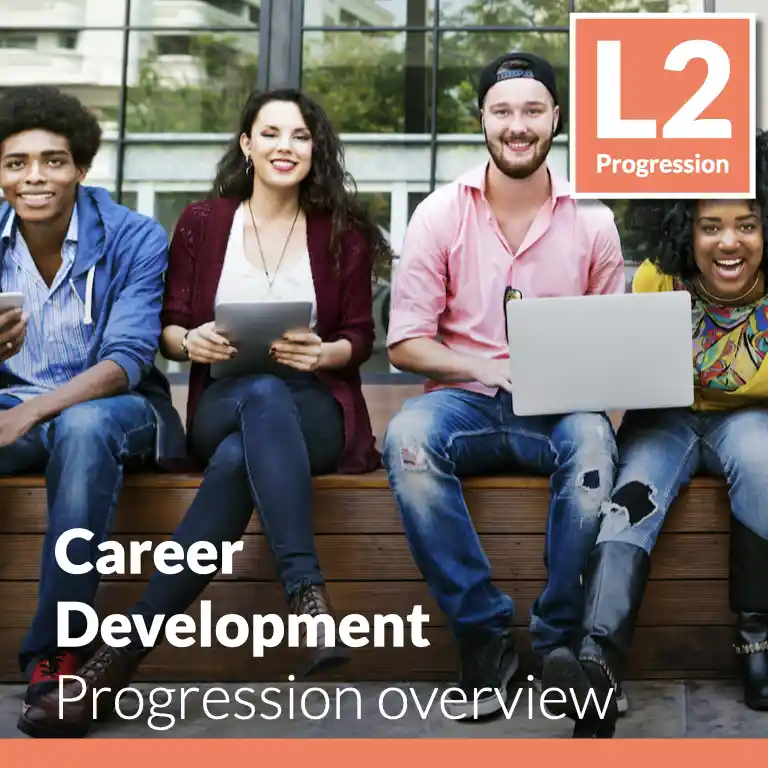Enjoy instant access to a scalable system of proven practices and execution-ready tools. Built to launch strategic HR programs 5X faster!
✓ Enjoy platform access
✓ Create your HR roadmap
✓ View open content in library
✓ Access dozens of practices:
⤷ The HR Strategy program
⤷ Explainers and deep dives
⤷ Supplemental guides
⤷ Insight articles
⤷ Weekly best practices
⤷ And more!
100% Free. No credit card required.
This guide is part of a progression set comprised of Core, Advanced, and Emerging Career Development practices.
Advanced Career Development creates and manages a culture of career mobility by building a structured foundation for comparing jobs with overlapping capability requirements. Moving beyond only job requirements and experience creates heightened consistency and clarity regarding the drivers of successful job performance in each role by developing competency models that outline the primary capabilities that an employee will exercise to create the greatest value while in the role. It actively engages all employees in job mobility as a critical development exercise. At the same time, leaders and functional managers actively promote and support transfers for individual development and to meet evolving business needs. Additionally, it identifies career paths that are not only vertical and within a function but also include lateral and cross-functional movement. It becomes a standard aspect of a career in the organization with upward mobility and across roles for broader development opportunities that map to an individual’s strengths and preferences.
Technology plays a significant role in automated HR and Talent systems, organizing roles and their requirements, providing transparency of career options, integrating data from other HR processes, and recommending career paths and learning options aligned to employee skills, goals, and aspirations. It creates transparent requirements for higher-level and developmental assignments that open new positions and career opportunities for all employees.
When combined with transparent job roles and requirements, a culture of mobility fosters enhanced fairness and access to growth for all employees, including those who may not be initially identified by their managers for promotion or development assignments. This approach democratizes the career development process, paving the way for a more diverse and inclusive set of future leaders and critical role contributors. It also addresses talent shortages by using promotions to fill higher-level and more sophisticated roles while recruiting more plentiful lower-skilled candidates to replace those who have been promoted.
Changes in career development expectations, particularly among the younger generations, who are increasingly becoming a large portion of the total workforce, are driving much of this focus. For instance, Gen Y and Z workers have higher career development and growth aspirations than their predecessors. Career growth is often cited as a top reason employees continue working for an organization. This longer-term career development thinking fosters a culture of mobility and continuous learning and development, which can support an organization’s need for agility and adaptability to advance in key career fields over time.
Adopting these practices creates an environment of growth and advancement that drives employee retention and engagement, as development and advancement are two primary drivers of those talent outcomes. They generate greater clarity related to what is needed to succeed in a role and to be considered for advancement into more demanding and advanced roles. They provide a dramatically broadened set of career possibilities, with cross-functional and -business unit career moves increasingly possible for many employees. Such movement benefits the organization, as increased sharing of ideas, cross-fertilization of work methods, and broadened employee networks provide significant opportunities for a more innovative workforce. It also gives managers more relevant insights into those benefits and how they can guide employees with specialized skills and aspirations toward more advanced positions that best serve the entire organization’s preferences and business requirements. It creates a culture of greater fairness and equity, enabling previously “hidden” or higher potential talent to emerge through self-identification and more targeted development for employees who might operate with a lower and less self-promoting profile than others. By leveraging technologies, these practices enable better syndication and insights into employee skills, career possibilities, development opportunities, and intelligent recommendations to managers and employees alike. The deployment of such systems creates a much more dynamic and robust way for the company and its employees to simultaneously assess their needs, gaps, and resources to fulfill career ambitions and business staffing requirements.
Gaining buy-in and active support from leaders and employees for regular movement for the benefit of the larger business.
Identifying behavioral standards that guide the application of knowledge, skills, and abilities required for each role.
Creating pathways that inform the movement of people both vertically and horizontally, and within and across functional lines for unique development experiences and exposure.
Identifying and selecting systems that automate the manual work of competency development, success and talent profiles, and the identification of career paths and development options.

Enjoy instant access to a scalable system of proven practices and execution-ready tools. Built to launch strategic HR programs 5X faster!